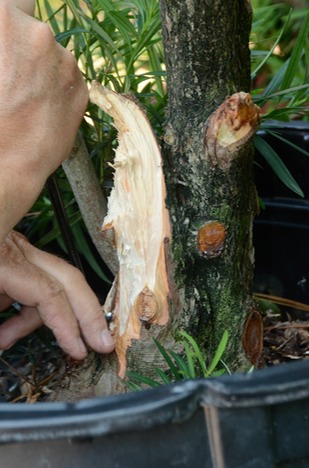Jin and Shari Program April 18, 2013
Carving on bonsai can add age to a tree, create an interesting focal point on the tree, enhance a beautiful twisted lifeline along a trunk or branch, or add an artistic element that may effectively "fill" an empty space. Jin typically means dead wood at the end of a branch or the top of the tree. Shari is carved/dead wood within the tree.


Jin on podocarpus. Photos by Lynn Fabian
Care must be taken to protect yourself by using safety glasses, properly handling tools, both power and hand carving tools. A special note: many woods are toxic if inhaled or ingested! Take special care to wear a mask to protect your lungs, etc. from wood dust particularly when using power tools.
The carving should reflect the tree's origins or expand the story you are trying to tell with the tree. Did a lightning strike take the top out of the tree? Was the snow so heavy it broke a branch away and ripped some bark off the trunk? Did a hurricane rip off several branches leaving both gin and shari?
Not all trees are well suited to having carved wood as part of the tree. So called 'soft wood' trees have short fibers and/or will rot more readily than the 'hard woods'. Junipers, bristle cone pines, podocarpus and others will accept carving without yielding to rot too quickly. All carved areas need to be treated with some sort of fungus control. One typical product is lime sulphur, a fungicide that is still available on the market. The stark white result can be controlled by diluting the lime sulfur 1:2, 1:3, etc. (sulfur to water ratio); not for use in the landscape. Another note: protect live wood and the bonsai soil from the lime sulfur.
The carving you do on a tree should try to mimic a termite or fungus activity. These critters will go for the softest wood first and leave behind some high ridges and low valleys that imply the tree has aged slowly and naturally. So think like a termite or funguy (sic).
The examples we usually see of carving jin and shari are on very large trees. This plant material is not always available to the casual bonsaist. That is no reason not to try your hand at creating a jin or two on any suitable tree to enhance the image of the art.
Sometimes carving is done because you can and then there are those OOPS! times when you lose or break a branch you really needed. Try a jin … or a gin and tonic (or whatever palliative of choice) if it was a REALLY important branch! –Lynn & Ed